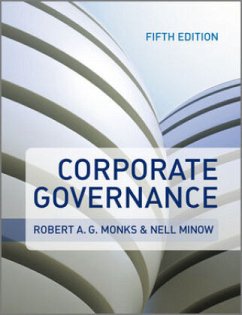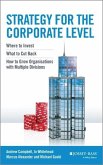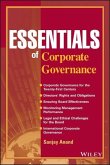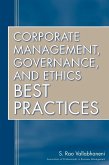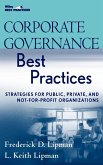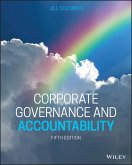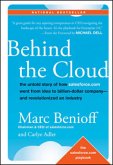- Broschiertes Buch
- Merkliste
- Auf die Merkliste
- Bewerten Bewerten
- Teilen
- Produkt teilen
- Produkterinnerung
- Produkterinnerung
In the wake of the recent global financial collapse the timely new edition of this successful text provides students and business professionals with a welcome update of the key issues facing managers, boards of directors, investors, and shareholders.
In addition to its authoritative overview of the history, the myth and the reality of corporate governance, this new edition has been updated to include: analysis of the financial crisis; the reasons for the global scale of the recession the failure of international risk management An overview of corporate governance guidelines and codes of…mehr
Andere Kunden interessierten sich auch für
![Strategy for the Corporate Level Strategy for the Corporate Level]() Andrew CampbellStrategy for the Corporate Level60,99 €
Andrew CampbellStrategy for the Corporate Level60,99 €![Innovation Governance Innovation Governance]() Jean-Philippe DeschampsInnovation Governance42,99 €
Jean-Philippe DeschampsInnovation Governance42,99 €![Essentials of Corporate Governance Essentials of Corporate Governance]() Sanjay AnandEssentials of Corporate Governance31,99 €
Sanjay AnandEssentials of Corporate Governance31,99 €![Corporate Management, Governance, and Ethics Best Practices Corporate Management, Governance, and Ethics Best Practices]() S. Rao VallabhaneniCorporate Management, Governance, and Ethics Best Practices87,99 €
S. Rao VallabhaneniCorporate Management, Governance, and Ethics Best Practices87,99 €![Corporate Governance Best Practices Corporate Governance Best Practices]() Frederick D. LipmanCorporate Governance Best Practices90,99 €
Frederick D. LipmanCorporate Governance Best Practices90,99 €![Corporate Governance and Accountability Corporate Governance and Accountability]() Jill SolomonCorporate Governance and Accountability60,99 €
Jill SolomonCorporate Governance and Accountability60,99 €![Behind the Cloud Behind the Cloud]() Marc BenioffBehind the Cloud19,99 €
Marc BenioffBehind the Cloud19,99 €-
-
-
In the wake of the recent global financial collapse the timely new edition of this successful text provides students and business professionals with a welcome update of the key issues facing managers, boards of directors, investors, and shareholders.
In addition to its authoritative overview of the history, the myth and the reality of corporate governance, this new edition has been updated to include:
analysis of the financial crisis;
the reasons for the global scale of the recession
the failure of international risk management
An overview of corporate governance guidelines and codes of practice;
new cases.
Once again in the new edition of their textbook, Robert A. G. Monks and Nell Minow show clearly the role of corporate governance in making sure the right questions are asked and the necessary checks and balances in place to protect the long-term, sustainable value of the enterprise.
Features 18 case studies of institutions and corporations in crisis, and analyses the reasons for their fall (Cases include Lehman Brothers, General Motors, American Express, Time Warner, IBM and Premier Oil.)
Hinweis: Dieser Artikel kann nur an eine deutsche Lieferadresse ausgeliefert werden.
In addition to its authoritative overview of the history, the myth and the reality of corporate governance, this new edition has been updated to include:
analysis of the financial crisis;
the reasons for the global scale of the recession
the failure of international risk management
An overview of corporate governance guidelines and codes of practice;
new cases.
Once again in the new edition of their textbook, Robert A. G. Monks and Nell Minow show clearly the role of corporate governance in making sure the right questions are asked and the necessary checks and balances in place to protect the long-term, sustainable value of the enterprise.
Features 18 case studies of institutions and corporations in crisis, and analyses the reasons for their fall (Cases include Lehman Brothers, General Motors, American Express, Time Warner, IBM and Premier Oil.)
Hinweis: Dieser Artikel kann nur an eine deutsche Lieferadresse ausgeliefert werden.
Produktdetails
- Produktdetails
- Verlag: Wiley & Sons
- Artikelnr. des Verlages: 14597259000
- 5. Aufl.
- Seitenzahl: 544
- Erscheinungstermin: 8. Juli 2011
- Englisch
- Abmessung: 233mm x 190mm x 28mm
- Gewicht: 1080g
- ISBN-13: 9780470972595
- ISBN-10: 0470972599
- Artikelnr.: 32959523
- Herstellerkennzeichnung
- Libri GmbH
- Europaallee 1
- 36244 Bad Hersfeld
- gpsr@libri.de
- Verlag: Wiley & Sons
- Artikelnr. des Verlages: 14597259000
- 5. Aufl.
- Seitenzahl: 544
- Erscheinungstermin: 8. Juli 2011
- Englisch
- Abmessung: 233mm x 190mm x 28mm
- Gewicht: 1080g
- ISBN-13: 9780470972595
- ISBN-10: 0470972599
- Artikelnr.: 32959523
- Herstellerkennzeichnung
- Libri GmbH
- Europaallee 1
- 36244 Bad Hersfeld
- gpsr@libri.de
Robert A.G. Monks and Nell Minow are founders of GovernanceMetrics International, the leading independent research firm dedicated to corporate governance. Formerly principals of the Lens Fund and officers of Institutional Shareholder Services, Monks & Minow have also collaborated on two other books: Power and Accountability and Watching the Watchers.
Cases in Point xiii
Preface xvii
Acknowledgments xxvii
Introduction - How to Use this Book 1
1. What is a Corporation? 3
Defining the Corporate Structure, Purpose, and Powers 5
Evolution of the Corporate Structure 6
The Purpose of a Corporation 9
Satisfying the human need for ambition, creativity, and meaning 9
Social structure 10
Efficiency and efficacy 10
Ubiquity and flexibility 11
Identity 11
Metaphor 1: The Corporation as a "Person" 12
Metaphor 2: The Corporation as a Complex Adaptive System 12
Are Corporate Decisions "Moral"? 14
Are Corporations Accountable? 16
Three Key External Mechanisms for Directing Corporate Behavior: Law, the
Market, and Performance Measurement 18
Government: legislation, regulation, enforcement 18
What Does "Within the Limits of the Law" Mean? 20
When and how do you punish a corporation? 28
Probation of corporations 29
The problem of serial offenders 31
Securities analyst settlement 32
What is the role of shareholders in making this system work? 33
The market: too big to fail 36
The corporation and elections 40
Citizens united 41
The corporation and the law 45
A Market Test: Measuring Performance 47
Long term versus short term 50
Corporate decision making: whose interests does this "person"/adaptive
creature serve? 55
Another (failed) market test: NGOs 61
Measuring value enhancement 62
Gaap 62
Market value 69
Earnings per share 70
EVA ® : economic value added 71
Human capital: "It's not what you own but what you know" 72
The "value chain" 73
Knowledge capital 74
The value of cash 74
Corporate "externalities" 79
Equilibrium: The Cadbury Paradigm 79
ESG: Environment, Social Governance - A New Way to Analyze Investment Risk
and Value 83
Quantifying Nontraditional Assets and Liabilities 87
Future Directions 92
Summary and Discussion Questions 93
Notes 95
2. Shareholders: Ownership 101
Definitions 105
Early Concepts of Ownership 106
Early Concepts of the Corporation 107
A Dual Heritage: Individual and Corporate "Rights" 108
The Reinvention of the Corporation: Eastern Europe in the 1990s 110
The Evolution of the American Corporation 111
The Essential Elements of the Corporate Structure 115
The Mechanics of Shareholder Rights 117
The Separation of Ownership and Control, Part 1: Berle and Means 118
Fractionated Ownership 125
The Separation of Ownership and Control, Part 2: The Takeover Era 129
Waking the Sleeping Giant 134
A Framework for Shareholder Monitoring and Response 140
Ownership and Responsibility 141
No innocent shareholder 141
To Sell or Not to Sell: The Prisoner's Dilemma 143
Who the Institutional Investors Are 144
Bank trusts 145
Mutual funds 146
Insurance companies 149
Universities and foundations 149
Executive pay from the consumer side - a leading indicator of risk 150
Pension plans 154
The Biggest Pool of Money in the World 154
Pension plans as investors 164
Pension plans as owners 166
Public Pension Funds 169
Divestment initiatives 188
Economically targeted investments 189
Afscme 195
Federal Employees' Retirement System 197
Tiaa-cref 199
Private Pension Funds 201
The Sleeping Giant Awakens: Shareholder Proxy Proposals on Governance
Issues 206
Focus on the Board 212
Hedge Funds 220
Synthesis: Hermes 221
Investing in Activism 222
New Models and New Paradigms 223
The "Ideal Owner" 228
Pension Funds as "Ideal Owners" 233
Is the "Ideal Owner" Enough? 234
Summary and Discussion Questions 236
Notes 238
3. Directors: Monitoring 251
A Brief History of Anglo-American Boards 255
Who Are They? 256
Size 256
Term 256
Inside/outside mix 257
Qualifications 261
Who Leads the Board? Splitting the Chairman and CEO and the Rise of the
Lead Director 261
Agenda 263
Minutes 263
Diversity 264
Meetings 264
Communicating with Shareholders 264
Special Obligations of Audit Committees 265
Ownership/Compensation 266
Post-Sarbanes-Oxley Changes 266
Board Duties: The Legal Framework 267
The Board's Agenda 281
The Evolution of Board Responsibilities: The Takeover Era 283
The Fiduciary Standard and the Delaware Factor 284
How did boards respond? 287
Greenmail 287
"Poison pills" 288
Other anti-takeover devices 290
The Director's Role in Crisis 291
Limits and Obstacles to Board Oversight of Managers 295
Information Flow 295
Practical Limits: Time and Money 301
The Years of Corporate Scandals - Boards Begin to Ask for More 302
Director Information Checklist 303
Who Runs the Board? 304
Catch 22: The Ex-CEO as Director 306
Director Resignation 308
CEO Succession 308
Director Nomination 309
Limits and Obstacles to Effective Board Oversight by Shareholders 318
Carrots: Director Compensation and Incentives 319
Sticks, Part 1: Can Investors Ensure or Improve Board Independence by
Replacing Directors who Perform Badly or Suing Directors who Fail to Act as
Fiduciaries? 324
Can Directors be Held Accountable through the Election Process? 324
Staggered boards 327
Confidential voting 328
Sticks, Part 2: Suing for Failure to Protect the Interests of Shareholders
- Are the Duties of Care and Loyalty Enforceable? 331
Future Directions 331
Majority voting and proxy access 331
Improving director compensation 333
Increasing the authority of independent directors 333
"A market for independent directors" 335
"Designated director" 336
Board evaluation 336
Executive session meetings 336
Succession planning and strategic planning 337
Making directors genuinely "independent" 337
Involvement by the federal government 338
Involvement by shareholders 339
Summary and Discussion Questions 339
Notes 340
4. Management: Performance 347
Introduction 348
What Do We Want from the CEO? 354
The Biggest Challenge 359
Risk Management 363
Executive Compensation 363
The pay Czar 370
Post-meltdown pay 370
The Council of Institutional Investors 371
Stock Options 374
Restricted Stock 379
Yes, We Have Good Examples 380
Shareholder Concerns: Several Ways to Pay Day 380
The "guaranteed bonus" - the ultimate oxymoron 380
Deliberate obfuscation 381
The Christmas tree 382
Compensation plans that are all upside and no downside 382
Loans 382
Accelerated vesting of options 383
Manipulation of earnings to support bonuses 383
Manipulation of peer groups 384
Huge disparity between CEO and other top executives 384
Imputed years of service 384
Excessive departure packages 384
Backdating, bullet-dodging, and spring-loading options 385
Phony cuts 386
Golden hellos 386
Transaction bonuses 386
Gross-ups and other perquisites 387
Retirement benefits 387
Obstacles to restitution when CEOs are overpaid 387
Future Directions for Executive Compensation 388
CEO Employment Contracts 389
Cause 390
Change of control 391
Half now, half later 391
CEO Succession Planning 391
Sarbanes-Oxley 392
Creation of the Public Company Accounting Oversight Board 392
Section 404 393
Other changes 394
Dodd-Frank 394
Employees: Compensation and Ownership 395
Employee Stock Ownership Plans 399
Mondragón and Symmetry: Integration of Employees, Owners, and Directors 403
Conclusion 409
Summary and Discussion Questions 410
Notes 411
5. International Corporate Governance 415
The Institutional Investor as Proxy for the Public Interest 429
Norway in the driver's seat 431
The International Corporate Governance Network 433
ICGN: Statement of Principles on Institutional Shareholder Responsibilities
433
The Global Corporate Governance Forum 435
Sweden 435
Canada 437
Singapore 438
Russia 441
Germany 442
China 443
Japan 444
GovernanceMetrics International (GMI) 445
World Bank and G7 Response 458
Azerbaijan 459
Slovakia 460
Jordan 460
Thailand 461
Poland 461
The Global Carbon Project (GCP) 464
A Common Framework for Sustainability Reporting 465
Towards a Common Language 468
Vision 470
Summary And Discussion Questions 471
Notes 473
6. Afterword: Final Thoughts and Future Directions 475
Beyond the Nation State 477
Government as Shareholder: The Institutional Investor as Proxy for the
Public Interest 484
Notes 486
Index 489
Preface xvii
Acknowledgments xxvii
Introduction - How to Use this Book 1
1. What is a Corporation? 3
Defining the Corporate Structure, Purpose, and Powers 5
Evolution of the Corporate Structure 6
The Purpose of a Corporation 9
Satisfying the human need for ambition, creativity, and meaning 9
Social structure 10
Efficiency and efficacy 10
Ubiquity and flexibility 11
Identity 11
Metaphor 1: The Corporation as a "Person" 12
Metaphor 2: The Corporation as a Complex Adaptive System 12
Are Corporate Decisions "Moral"? 14
Are Corporations Accountable? 16
Three Key External Mechanisms for Directing Corporate Behavior: Law, the
Market, and Performance Measurement 18
Government: legislation, regulation, enforcement 18
What Does "Within the Limits of the Law" Mean? 20
When and how do you punish a corporation? 28
Probation of corporations 29
The problem of serial offenders 31
Securities analyst settlement 32
What is the role of shareholders in making this system work? 33
The market: too big to fail 36
The corporation and elections 40
Citizens united 41
The corporation and the law 45
A Market Test: Measuring Performance 47
Long term versus short term 50
Corporate decision making: whose interests does this "person"/adaptive
creature serve? 55
Another (failed) market test: NGOs 61
Measuring value enhancement 62
Gaap 62
Market value 69
Earnings per share 70
EVA ® : economic value added 71
Human capital: "It's not what you own but what you know" 72
The "value chain" 73
Knowledge capital 74
The value of cash 74
Corporate "externalities" 79
Equilibrium: The Cadbury Paradigm 79
ESG: Environment, Social Governance - A New Way to Analyze Investment Risk
and Value 83
Quantifying Nontraditional Assets and Liabilities 87
Future Directions 92
Summary and Discussion Questions 93
Notes 95
2. Shareholders: Ownership 101
Definitions 105
Early Concepts of Ownership 106
Early Concepts of the Corporation 107
A Dual Heritage: Individual and Corporate "Rights" 108
The Reinvention of the Corporation: Eastern Europe in the 1990s 110
The Evolution of the American Corporation 111
The Essential Elements of the Corporate Structure 115
The Mechanics of Shareholder Rights 117
The Separation of Ownership and Control, Part 1: Berle and Means 118
Fractionated Ownership 125
The Separation of Ownership and Control, Part 2: The Takeover Era 129
Waking the Sleeping Giant 134
A Framework for Shareholder Monitoring and Response 140
Ownership and Responsibility 141
No innocent shareholder 141
To Sell or Not to Sell: The Prisoner's Dilemma 143
Who the Institutional Investors Are 144
Bank trusts 145
Mutual funds 146
Insurance companies 149
Universities and foundations 149
Executive pay from the consumer side - a leading indicator of risk 150
Pension plans 154
The Biggest Pool of Money in the World 154
Pension plans as investors 164
Pension plans as owners 166
Public Pension Funds 169
Divestment initiatives 188
Economically targeted investments 189
Afscme 195
Federal Employees' Retirement System 197
Tiaa-cref 199
Private Pension Funds 201
The Sleeping Giant Awakens: Shareholder Proxy Proposals on Governance
Issues 206
Focus on the Board 212
Hedge Funds 220
Synthesis: Hermes 221
Investing in Activism 222
New Models and New Paradigms 223
The "Ideal Owner" 228
Pension Funds as "Ideal Owners" 233
Is the "Ideal Owner" Enough? 234
Summary and Discussion Questions 236
Notes 238
3. Directors: Monitoring 251
A Brief History of Anglo-American Boards 255
Who Are They? 256
Size 256
Term 256
Inside/outside mix 257
Qualifications 261
Who Leads the Board? Splitting the Chairman and CEO and the Rise of the
Lead Director 261
Agenda 263
Minutes 263
Diversity 264
Meetings 264
Communicating with Shareholders 264
Special Obligations of Audit Committees 265
Ownership/Compensation 266
Post-Sarbanes-Oxley Changes 266
Board Duties: The Legal Framework 267
The Board's Agenda 281
The Evolution of Board Responsibilities: The Takeover Era 283
The Fiduciary Standard and the Delaware Factor 284
How did boards respond? 287
Greenmail 287
"Poison pills" 288
Other anti-takeover devices 290
The Director's Role in Crisis 291
Limits and Obstacles to Board Oversight of Managers 295
Information Flow 295
Practical Limits: Time and Money 301
The Years of Corporate Scandals - Boards Begin to Ask for More 302
Director Information Checklist 303
Who Runs the Board? 304
Catch 22: The Ex-CEO as Director 306
Director Resignation 308
CEO Succession 308
Director Nomination 309
Limits and Obstacles to Effective Board Oversight by Shareholders 318
Carrots: Director Compensation and Incentives 319
Sticks, Part 1: Can Investors Ensure or Improve Board Independence by
Replacing Directors who Perform Badly or Suing Directors who Fail to Act as
Fiduciaries? 324
Can Directors be Held Accountable through the Election Process? 324
Staggered boards 327
Confidential voting 328
Sticks, Part 2: Suing for Failure to Protect the Interests of Shareholders
- Are the Duties of Care and Loyalty Enforceable? 331
Future Directions 331
Majority voting and proxy access 331
Improving director compensation 333
Increasing the authority of independent directors 333
"A market for independent directors" 335
"Designated director" 336
Board evaluation 336
Executive session meetings 336
Succession planning and strategic planning 337
Making directors genuinely "independent" 337
Involvement by the federal government 338
Involvement by shareholders 339
Summary and Discussion Questions 339
Notes 340
4. Management: Performance 347
Introduction 348
What Do We Want from the CEO? 354
The Biggest Challenge 359
Risk Management 363
Executive Compensation 363
The pay Czar 370
Post-meltdown pay 370
The Council of Institutional Investors 371
Stock Options 374
Restricted Stock 379
Yes, We Have Good Examples 380
Shareholder Concerns: Several Ways to Pay Day 380
The "guaranteed bonus" - the ultimate oxymoron 380
Deliberate obfuscation 381
The Christmas tree 382
Compensation plans that are all upside and no downside 382
Loans 382
Accelerated vesting of options 383
Manipulation of earnings to support bonuses 383
Manipulation of peer groups 384
Huge disparity between CEO and other top executives 384
Imputed years of service 384
Excessive departure packages 384
Backdating, bullet-dodging, and spring-loading options 385
Phony cuts 386
Golden hellos 386
Transaction bonuses 386
Gross-ups and other perquisites 387
Retirement benefits 387
Obstacles to restitution when CEOs are overpaid 387
Future Directions for Executive Compensation 388
CEO Employment Contracts 389
Cause 390
Change of control 391
Half now, half later 391
CEO Succession Planning 391
Sarbanes-Oxley 392
Creation of the Public Company Accounting Oversight Board 392
Section 404 393
Other changes 394
Dodd-Frank 394
Employees: Compensation and Ownership 395
Employee Stock Ownership Plans 399
Mondragón and Symmetry: Integration of Employees, Owners, and Directors 403
Conclusion 409
Summary and Discussion Questions 410
Notes 411
5. International Corporate Governance 415
The Institutional Investor as Proxy for the Public Interest 429
Norway in the driver's seat 431
The International Corporate Governance Network 433
ICGN: Statement of Principles on Institutional Shareholder Responsibilities
433
The Global Corporate Governance Forum 435
Sweden 435
Canada 437
Singapore 438
Russia 441
Germany 442
China 443
Japan 444
GovernanceMetrics International (GMI) 445
World Bank and G7 Response 458
Azerbaijan 459
Slovakia 460
Jordan 460
Thailand 461
Poland 461
The Global Carbon Project (GCP) 464
A Common Framework for Sustainability Reporting 465
Towards a Common Language 468
Vision 470
Summary And Discussion Questions 471
Notes 473
6. Afterword: Final Thoughts and Future Directions 475
Beyond the Nation State 477
Government as Shareholder: The Institutional Investor as Proxy for the
Public Interest 484
Notes 486
Index 489
Cases in Point xiii
Preface xvii
Acknowledgments xxvii
Introduction - How to Use this Book 1
1. What is a Corporation? 3
Defining the Corporate Structure, Purpose, and Powers 5
Evolution of the Corporate Structure 6
The Purpose of a Corporation 9
Satisfying the human need for ambition, creativity, and meaning 9
Social structure 10
Efficiency and efficacy 10
Ubiquity and flexibility 11
Identity 11
Metaphor 1: The Corporation as a "Person" 12
Metaphor 2: The Corporation as a Complex Adaptive System 12
Are Corporate Decisions "Moral"? 14
Are Corporations Accountable? 16
Three Key External Mechanisms for Directing Corporate Behavior: Law, the
Market, and Performance Measurement 18
Government: legislation, regulation, enforcement 18
What Does "Within the Limits of the Law" Mean? 20
When and how do you punish a corporation? 28
Probation of corporations 29
The problem of serial offenders 31
Securities analyst settlement 32
What is the role of shareholders in making this system work? 33
The market: too big to fail 36
The corporation and elections 40
Citizens united 41
The corporation and the law 45
A Market Test: Measuring Performance 47
Long term versus short term 50
Corporate decision making: whose interests does this "person"/adaptive
creature serve? 55
Another (failed) market test: NGOs 61
Measuring value enhancement 62
Gaap 62
Market value 69
Earnings per share 70
EVA ® : economic value added 71
Human capital: "It's not what you own but what you know" 72
The "value chain" 73
Knowledge capital 74
The value of cash 74
Corporate "externalities" 79
Equilibrium: The Cadbury Paradigm 79
ESG: Environment, Social Governance - A New Way to Analyze Investment Risk
and Value 83
Quantifying Nontraditional Assets and Liabilities 87
Future Directions 92
Summary and Discussion Questions 93
Notes 95
2. Shareholders: Ownership 101
Definitions 105
Early Concepts of Ownership 106
Early Concepts of the Corporation 107
A Dual Heritage: Individual and Corporate "Rights" 108
The Reinvention of the Corporation: Eastern Europe in the 1990s 110
The Evolution of the American Corporation 111
The Essential Elements of the Corporate Structure 115
The Mechanics of Shareholder Rights 117
The Separation of Ownership and Control, Part 1: Berle and Means 118
Fractionated Ownership 125
The Separation of Ownership and Control, Part 2: The Takeover Era 129
Waking the Sleeping Giant 134
A Framework for Shareholder Monitoring and Response 140
Ownership and Responsibility 141
No innocent shareholder 141
To Sell or Not to Sell: The Prisoner's Dilemma 143
Who the Institutional Investors Are 144
Bank trusts 145
Mutual funds 146
Insurance companies 149
Universities and foundations 149
Executive pay from the consumer side - a leading indicator of risk 150
Pension plans 154
The Biggest Pool of Money in the World 154
Pension plans as investors 164
Pension plans as owners 166
Public Pension Funds 169
Divestment initiatives 188
Economically targeted investments 189
Afscme 195
Federal Employees' Retirement System 197
Tiaa-cref 199
Private Pension Funds 201
The Sleeping Giant Awakens: Shareholder Proxy Proposals on Governance
Issues 206
Focus on the Board 212
Hedge Funds 220
Synthesis: Hermes 221
Investing in Activism 222
New Models and New Paradigms 223
The "Ideal Owner" 228
Pension Funds as "Ideal Owners" 233
Is the "Ideal Owner" Enough? 234
Summary and Discussion Questions 236
Notes 238
3. Directors: Monitoring 251
A Brief History of Anglo-American Boards 255
Who Are They? 256
Size 256
Term 256
Inside/outside mix 257
Qualifications 261
Who Leads the Board? Splitting the Chairman and CEO and the Rise of the
Lead Director 261
Agenda 263
Minutes 263
Diversity 264
Meetings 264
Communicating with Shareholders 264
Special Obligations of Audit Committees 265
Ownership/Compensation 266
Post-Sarbanes-Oxley Changes 266
Board Duties: The Legal Framework 267
The Board's Agenda 281
The Evolution of Board Responsibilities: The Takeover Era 283
The Fiduciary Standard and the Delaware Factor 284
How did boards respond? 287
Greenmail 287
"Poison pills" 288
Other anti-takeover devices 290
The Director's Role in Crisis 291
Limits and Obstacles to Board Oversight of Managers 295
Information Flow 295
Practical Limits: Time and Money 301
The Years of Corporate Scandals - Boards Begin to Ask for More 302
Director Information Checklist 303
Who Runs the Board? 304
Catch 22: The Ex-CEO as Director 306
Director Resignation 308
CEO Succession 308
Director Nomination 309
Limits and Obstacles to Effective Board Oversight by Shareholders 318
Carrots: Director Compensation and Incentives 319
Sticks, Part 1: Can Investors Ensure or Improve Board Independence by
Replacing Directors who Perform Badly or Suing Directors who Fail to Act as
Fiduciaries? 324
Can Directors be Held Accountable through the Election Process? 324
Staggered boards 327
Confidential voting 328
Sticks, Part 2: Suing for Failure to Protect the Interests of Shareholders
- Are the Duties of Care and Loyalty Enforceable? 331
Future Directions 331
Majority voting and proxy access 331
Improving director compensation 333
Increasing the authority of independent directors 333
"A market for independent directors" 335
"Designated director" 336
Board evaluation 336
Executive session meetings 336
Succession planning and strategic planning 337
Making directors genuinely "independent" 337
Involvement by the federal government 338
Involvement by shareholders 339
Summary and Discussion Questions 339
Notes 340
4. Management: Performance 347
Introduction 348
What Do We Want from the CEO? 354
The Biggest Challenge 359
Risk Management 363
Executive Compensation 363
The pay Czar 370
Post-meltdown pay 370
The Council of Institutional Investors 371
Stock Options 374
Restricted Stock 379
Yes, We Have Good Examples 380
Shareholder Concerns: Several Ways to Pay Day 380
The "guaranteed bonus" - the ultimate oxymoron 380
Deliberate obfuscation 381
The Christmas tree 382
Compensation plans that are all upside and no downside 382
Loans 382
Accelerated vesting of options 383
Manipulation of earnings to support bonuses 383
Manipulation of peer groups 384
Huge disparity between CEO and other top executives 384
Imputed years of service 384
Excessive departure packages 384
Backdating, bullet-dodging, and spring-loading options 385
Phony cuts 386
Golden hellos 386
Transaction bonuses 386
Gross-ups and other perquisites 387
Retirement benefits 387
Obstacles to restitution when CEOs are overpaid 387
Future Directions for Executive Compensation 388
CEO Employment Contracts 389
Cause 390
Change of control 391
Half now, half later 391
CEO Succession Planning 391
Sarbanes-Oxley 392
Creation of the Public Company Accounting Oversight Board 392
Section 404 393
Other changes 394
Dodd-Frank 394
Employees: Compensation and Ownership 395
Employee Stock Ownership Plans 399
Mondragón and Symmetry: Integration of Employees, Owners, and Directors 403
Conclusion 409
Summary and Discussion Questions 410
Notes 411
5. International Corporate Governance 415
The Institutional Investor as Proxy for the Public Interest 429
Norway in the driver's seat 431
The International Corporate Governance Network 433
ICGN: Statement of Principles on Institutional Shareholder Responsibilities
433
The Global Corporate Governance Forum 435
Sweden 435
Canada 437
Singapore 438
Russia 441
Germany 442
China 443
Japan 444
GovernanceMetrics International (GMI) 445
World Bank and G7 Response 458
Azerbaijan 459
Slovakia 460
Jordan 460
Thailand 461
Poland 461
The Global Carbon Project (GCP) 464
A Common Framework for Sustainability Reporting 465
Towards a Common Language 468
Vision 470
Summary And Discussion Questions 471
Notes 473
6. Afterword: Final Thoughts and Future Directions 475
Beyond the Nation State 477
Government as Shareholder: The Institutional Investor as Proxy for the
Public Interest 484
Notes 486
Index 489
Preface xvii
Acknowledgments xxvii
Introduction - How to Use this Book 1
1. What is a Corporation? 3
Defining the Corporate Structure, Purpose, and Powers 5
Evolution of the Corporate Structure 6
The Purpose of a Corporation 9
Satisfying the human need for ambition, creativity, and meaning 9
Social structure 10
Efficiency and efficacy 10
Ubiquity and flexibility 11
Identity 11
Metaphor 1: The Corporation as a "Person" 12
Metaphor 2: The Corporation as a Complex Adaptive System 12
Are Corporate Decisions "Moral"? 14
Are Corporations Accountable? 16
Three Key External Mechanisms for Directing Corporate Behavior: Law, the
Market, and Performance Measurement 18
Government: legislation, regulation, enforcement 18
What Does "Within the Limits of the Law" Mean? 20
When and how do you punish a corporation? 28
Probation of corporations 29
The problem of serial offenders 31
Securities analyst settlement 32
What is the role of shareholders in making this system work? 33
The market: too big to fail 36
The corporation and elections 40
Citizens united 41
The corporation and the law 45
A Market Test: Measuring Performance 47
Long term versus short term 50
Corporate decision making: whose interests does this "person"/adaptive
creature serve? 55
Another (failed) market test: NGOs 61
Measuring value enhancement 62
Gaap 62
Market value 69
Earnings per share 70
EVA ® : economic value added 71
Human capital: "It's not what you own but what you know" 72
The "value chain" 73
Knowledge capital 74
The value of cash 74
Corporate "externalities" 79
Equilibrium: The Cadbury Paradigm 79
ESG: Environment, Social Governance - A New Way to Analyze Investment Risk
and Value 83
Quantifying Nontraditional Assets and Liabilities 87
Future Directions 92
Summary and Discussion Questions 93
Notes 95
2. Shareholders: Ownership 101
Definitions 105
Early Concepts of Ownership 106
Early Concepts of the Corporation 107
A Dual Heritage: Individual and Corporate "Rights" 108
The Reinvention of the Corporation: Eastern Europe in the 1990s 110
The Evolution of the American Corporation 111
The Essential Elements of the Corporate Structure 115
The Mechanics of Shareholder Rights 117
The Separation of Ownership and Control, Part 1: Berle and Means 118
Fractionated Ownership 125
The Separation of Ownership and Control, Part 2: The Takeover Era 129
Waking the Sleeping Giant 134
A Framework for Shareholder Monitoring and Response 140
Ownership and Responsibility 141
No innocent shareholder 141
To Sell or Not to Sell: The Prisoner's Dilemma 143
Who the Institutional Investors Are 144
Bank trusts 145
Mutual funds 146
Insurance companies 149
Universities and foundations 149
Executive pay from the consumer side - a leading indicator of risk 150
Pension plans 154
The Biggest Pool of Money in the World 154
Pension plans as investors 164
Pension plans as owners 166
Public Pension Funds 169
Divestment initiatives 188
Economically targeted investments 189
Afscme 195
Federal Employees' Retirement System 197
Tiaa-cref 199
Private Pension Funds 201
The Sleeping Giant Awakens: Shareholder Proxy Proposals on Governance
Issues 206
Focus on the Board 212
Hedge Funds 220
Synthesis: Hermes 221
Investing in Activism 222
New Models and New Paradigms 223
The "Ideal Owner" 228
Pension Funds as "Ideal Owners" 233
Is the "Ideal Owner" Enough? 234
Summary and Discussion Questions 236
Notes 238
3. Directors: Monitoring 251
A Brief History of Anglo-American Boards 255
Who Are They? 256
Size 256
Term 256
Inside/outside mix 257
Qualifications 261
Who Leads the Board? Splitting the Chairman and CEO and the Rise of the
Lead Director 261
Agenda 263
Minutes 263
Diversity 264
Meetings 264
Communicating with Shareholders 264
Special Obligations of Audit Committees 265
Ownership/Compensation 266
Post-Sarbanes-Oxley Changes 266
Board Duties: The Legal Framework 267
The Board's Agenda 281
The Evolution of Board Responsibilities: The Takeover Era 283
The Fiduciary Standard and the Delaware Factor 284
How did boards respond? 287
Greenmail 287
"Poison pills" 288
Other anti-takeover devices 290
The Director's Role in Crisis 291
Limits and Obstacles to Board Oversight of Managers 295
Information Flow 295
Practical Limits: Time and Money 301
The Years of Corporate Scandals - Boards Begin to Ask for More 302
Director Information Checklist 303
Who Runs the Board? 304
Catch 22: The Ex-CEO as Director 306
Director Resignation 308
CEO Succession 308
Director Nomination 309
Limits and Obstacles to Effective Board Oversight by Shareholders 318
Carrots: Director Compensation and Incentives 319
Sticks, Part 1: Can Investors Ensure or Improve Board Independence by
Replacing Directors who Perform Badly or Suing Directors who Fail to Act as
Fiduciaries? 324
Can Directors be Held Accountable through the Election Process? 324
Staggered boards 327
Confidential voting 328
Sticks, Part 2: Suing for Failure to Protect the Interests of Shareholders
- Are the Duties of Care and Loyalty Enforceable? 331
Future Directions 331
Majority voting and proxy access 331
Improving director compensation 333
Increasing the authority of independent directors 333
"A market for independent directors" 335
"Designated director" 336
Board evaluation 336
Executive session meetings 336
Succession planning and strategic planning 337
Making directors genuinely "independent" 337
Involvement by the federal government 338
Involvement by shareholders 339
Summary and Discussion Questions 339
Notes 340
4. Management: Performance 347
Introduction 348
What Do We Want from the CEO? 354
The Biggest Challenge 359
Risk Management 363
Executive Compensation 363
The pay Czar 370
Post-meltdown pay 370
The Council of Institutional Investors 371
Stock Options 374
Restricted Stock 379
Yes, We Have Good Examples 380
Shareholder Concerns: Several Ways to Pay Day 380
The "guaranteed bonus" - the ultimate oxymoron 380
Deliberate obfuscation 381
The Christmas tree 382
Compensation plans that are all upside and no downside 382
Loans 382
Accelerated vesting of options 383
Manipulation of earnings to support bonuses 383
Manipulation of peer groups 384
Huge disparity between CEO and other top executives 384
Imputed years of service 384
Excessive departure packages 384
Backdating, bullet-dodging, and spring-loading options 385
Phony cuts 386
Golden hellos 386
Transaction bonuses 386
Gross-ups and other perquisites 387
Retirement benefits 387
Obstacles to restitution when CEOs are overpaid 387
Future Directions for Executive Compensation 388
CEO Employment Contracts 389
Cause 390
Change of control 391
Half now, half later 391
CEO Succession Planning 391
Sarbanes-Oxley 392
Creation of the Public Company Accounting Oversight Board 392
Section 404 393
Other changes 394
Dodd-Frank 394
Employees: Compensation and Ownership 395
Employee Stock Ownership Plans 399
Mondragón and Symmetry: Integration of Employees, Owners, and Directors 403
Conclusion 409
Summary and Discussion Questions 410
Notes 411
5. International Corporate Governance 415
The Institutional Investor as Proxy for the Public Interest 429
Norway in the driver's seat 431
The International Corporate Governance Network 433
ICGN: Statement of Principles on Institutional Shareholder Responsibilities
433
The Global Corporate Governance Forum 435
Sweden 435
Canada 437
Singapore 438
Russia 441
Germany 442
China 443
Japan 444
GovernanceMetrics International (GMI) 445
World Bank and G7 Response 458
Azerbaijan 459
Slovakia 460
Jordan 460
Thailand 461
Poland 461
The Global Carbon Project (GCP) 464
A Common Framework for Sustainability Reporting 465
Towards a Common Language 468
Vision 470
Summary And Discussion Questions 471
Notes 473
6. Afterword: Final Thoughts and Future Directions 475
Beyond the Nation State 477
Government as Shareholder: The Institutional Investor as Proxy for the
Public Interest 484
Notes 486
Index 489

